We have moved locations for our Missouri office, our new location is at 211 N. Lindbergh Blvd., Suite 201 Creve Coeur, MO 63141, excited to see you there!
Revision
Revision jaw surgery, also known as corrective jaw surgery or orthognathic surgery, is a surgical procedure performed to correct any complications or issues that may have arisen after a previous jaw surgery. This surgery is typically done to address functional problems or aesthetic abnormalities that were not fully resolved or have recurred following the initial surgery.
TMJ Fat graft Splint Therapy Revision
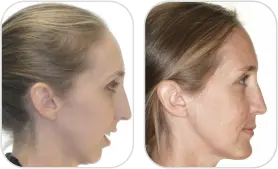
Before
After
LeFort I Osteotomy. Bilateral Total Joint Replacement (TJR). Genioplasty.
VIDEO INCLUDED
Previously, this patient had a fat graft surgery and an upper jaw surgery to help solve her
temporomandibular joint pain. Unfortunately these procedures did not resolve her symptoms
and conditions. Chronic pain, an open bite, and functional limitations left her desperate for a
solution.
TMJ Fat graft Splint Therapy Revision

Before
After
LeFort I Segmental Osteotomy. Bilateral Total Joint Replacement (TJR).
VIDEO INCLUDED
At 35 years old, she began experiencing severe headaches and sought help from a neurologist who prescribed medication that proved ineffective. By the time she was 45 years old, she was suffering from severe degenerative joint disease. Despite undergoing fat graft application around her jaw joints, discectomy, and years of splint therapy, her condition persisted.
Joint Orthographic Relapse

Before
After
Lefort 1 Segmental Osteotomy. Bilateral Total Joint Replacement (TJR).
VIDEO INCLUDED
She had multiple previous procedures before seeing Dr. Movahed. They included: splint therapy, arthrocentesis, and joint surgery for disc repositioning with unsuccessful results. She also had an unsuccessful double jaw surgery to address facial asymmetry and malocclusion. That procedure unfortunately worsened her joint pain and facial asymmetry.
Total Joint Surgery Revision
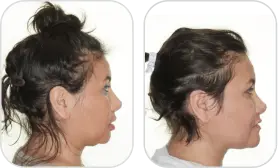
Before
After
Bilateral High Condylectomy. Lefort 1 Segmental Osteotomy. Bilateral Total Joint Replacement (TJR). Genioplasty.
She suffered from Severe Obstructive Sleep Apnea, which not only deprived her of sleep but also diminished her ability to cope with head and jaw pain related to TMJ dysfunction. Misaligned temporomandibular joint replacement (TJR) hardware from a previous surgery was causing functional problems and pain. Scar tissue from a previous spine surgery blocked her airway.
Total Joint Surgery Revision
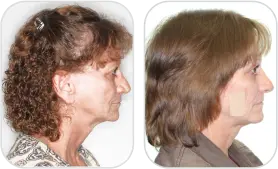
Before
After
Lefort 1 Segmental Osteotomy. Unilateral Total Joint Replacement (TJR). Quad Zygoma All on X Upper Jaw.
Her surgery was complicated due to a motor vehicle accident she had over 20 years ago. The trauma from the wreck resulted in multiple surgeries on both of her jaw joints. A left side total joint replacement (TJR) procedure failed.
Double Jaw Surgery Relapse

Before
After
LeFort 1 Segmental Osteotomy. Bilateral Total Joint Replacement (TJR). Genioplasty.
A failed maxillomandibular advancement (MMA) surgery, which did not include a counter clockwise rotation, left her with degenerative jaw joints. She experienced persistent jaw pain, limited mobility, and stiffness in her jaw muscles. She heard clicking and popping sounds whenever she moved her jaw, her teeth alignment was affected and she developed open mouth posture.
Double Jaw Surgery Relapse

Before
After
Lefort 1 Segmental Osteotomy. Bilateral Sagittal Split Osteotomy.
This patient’s journey began with a double jaw surgery, performed 30 years prior, which did not include a counter clockwise rotation. Over time, he experienced a relapse of both jaws, leading to narrowing of the palate and receding jaws, resulting in a “weak profile.” The narrowing of the palate affected the width of his smile. Additionally, his airway became narrower, causing sleep and breathing issues.
Double Jaw Surgery Relapse
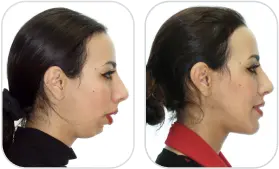
Before
After
LeFort 1 Segmental Osteotomy. Bilateral Total Joint Replacement (TJR).
She originally had a double surgery but unfortunately her jaw reset and was receding. She then decided to have a Bilateral Total Joint Replacement (TJR) with Dr. Movahed.
Revision of Mitek Anchor Surgery

Before
After
LeFort 1 Segmental Osteotomy. Bilateral Total Joint Replacement (TJR). Genioplasty.
After a disc repositioning procedure in 2007, this 33-year-old patient experienced five years of improved symptoms related to temporomandibular disorder (TMD) and articular disc displacement. However, over time, her range of motion decreased to just 5 mm, and an MRI revealed adhesion of the disc to the fossa with osteophytic changes.
Revision of Mitek Anchor Surgery
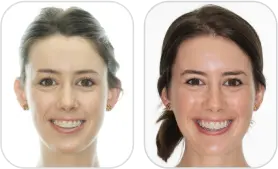
Before
After
Bilateral Total Joint Replacement (TJR)
Following a failed Mitek anchor disc repositioning procedure, this patient experienced retrognathia, – her lower jaw began to recede. Over time, her ability to open her jaw became limited which impacted her ability to eat and speak comfortably. Bi-lateral total joint replacement resolved her aesthetic, functional and quality of life issues.
Maxillomandibular advancement surgery Relapse
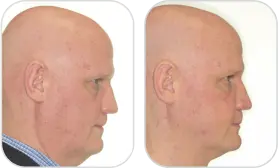
Before
After
Unilateral Total joint Replacement (TJR).
VIDEO INCLUDED
In 2008, the patient’s journey began with a diagnosis of sleep apnea and subsequent pain
related to nerve issues, bite problems, and misaligned teeth. After undergoing a double jaw
surgery that worsened his condition, he sought a solution and found Dr. Movahed.
Failed Joint Surgery Revision

Before
After
Unilateral Total joint Replacement (TJR).
This patient had so much jaw pain he could barely open his mouth or eat properly.
TMJ Fat graft Splint Therapy Revision
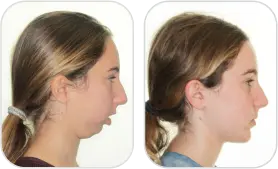
Before
After
LeFort 1 Segmental Osteotomy. Bilateral Total Joint Replacement (TJR).
At the age of 12, this patient underwent a discectomy and fat graft application to address her jaw condition. However, she continued to experience challenges with her jaw alignment. She came to see Dr. Movahed at age 17 with an anterior open bite, which refers to a lack of contact bet. After undergoing Dr. Movahed’s procedure, the 17-year-old female experienced a resolution of her symptoms.
